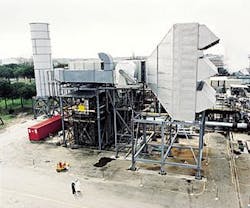General Electric Oil & Gas, a business unit of GE Power Systems, recently supplied a compressor train for the Malaysia LNG Tiga Sdn. Bhd. (No. 3) project at its Bintulu, Malaysia, plant.
We performed an exhaustive series of full-load tests for this project at the GE test facility in Massa, Italy, to verify turbocompressor performance and functionality of the main equipment. The critical nature of rotating equipment in the liquefaction chain demands this level of testing.
The Massa facility is equipped to string test complete trains of up to 100 Mw, allowing the reproduction of plant operating conditions, verification of performance and mechanical behavior of the units, and to meet stringent customer requirements.
Fig. 1 shows the Malaysia LNG (MLNG) Tiga compressor configuration. The mixed-refrigerant (MR) cycle uses a GE FR-7EA gas turbine with an ISO power rating of 86 Mw driving an AN 200 (low-pressure) axial compressor and a 2BCL 806 (high-pressure) centrifugal compressor. A 10-Mw variable speed electric motor assists in train start-up and as a helper when needed.
The propane cycle uses a similar gas turbine driver and electric motor starter-helper driving a 3MCL 1405 centrifugal compressor.
We had to exhaustively confirm the thermodynamic and mechanical performance of the machines over their entire operating range in the test facility due to:
•Innovative design solutions required for this machinery train.
•The need to precisely match the many process operating requirements.
•The customer's desire to minimize any tuning activities in the field to speed up commissioning.
In recent years, the evolution of LNG plants has spurred the continued development of compressors and drivers used for refrigeration processes. Capacity of a typical production line has grown to more than 5 million tonnes/year (tpy) for more recent plants from an average of 2 million tpy in the late 1980s. The size required for compressors and drivers has consequently increased.
Testing needs and requirements
The tests verify that, before shipping, the units comply with specifications and that they will work properly in the plant.
For most applications, customers require (for gas turbines and axial or centrifugal compressors) a "mechanical running test" in accordance with international specs (e.g., API 616 and 617). This allows the manufacturer to verify the machine's most critical mechanical parameters: rotor and casing vibrations, lube oil pressures, temperatures, flows, etc.
The ASME performance test code (PTC) 10 may require additional tests to verify the thermodynamic performance, especially for the compressors. Most of these tests are generally performed in indoor test facilities (Fig. 2).
The most exhaustive test is the full-load string test of the entire train. In this test, all the machines are coupled as they would be in the field (Fig. 3). The most critical auxiliary systems are also generally installed. Actual process conditions are reproduced closely, including gas characteristics (flows, pressures, temperatures), machine speeds, power absorbed, etc.
This test almost completely analyzes thermodynamic and mechanical behavior of the entire train including compressor performance curves, surge limit, machinery vibrations in steady-state and transient conditions, power absorbed, and efficiencies.
The test also fully verifies auxiliary systems, including the control system hardware and software used for the sequences and steady-state control. These tests are technically challenging and require experience, knowledge, and specific design, erection, and execution skills.
In the past 15 years, we have performed 23 full-load string tests involving most of the LNG turbomachinery trains supplied worldwide.
Test arrangement
We performed the MLNG Tiga train test in our Massa test facilities in spring 2001 in compliance with ASME PTC 10. We installed the turbocompressor units in a dedicated testing plant. The test environment included these subsystems:
•Turbocompressor train including main auxiliaries.
•Process gas loop with main auxiliaries (throttling valves, water and gas heat exchangers, process flow measurement devices, safety valves, gas analyzer).
•Transfer and filling system for process gas mixture.
•Natural gas boosting system for process and fuel gas.
•Water cooling system.
•Additional instrumentation other than customer plant instruments, which includes about 150 pressure and temperature probes inside the compressor and 100 process gas probes.
Fig. 4 shows a layout of the main test facilities dedicated to the LNG train full-load test.
The turbocompressor unit drivers were GE MS7001gas turbines (86 Mw at ISO conditions) plus a variable speed electric motor of approximately 10 Mw.
The MR compressor train consisted of a low-pressure AN 200 axial compressor and a high-pressure 2BCL 806 centrifugal compressor. The propane compressor was a 3MCL 1405 centrifugal compressor.
The outdoor string test used these main project auxiliaries:
- Gas turbine and compressors assembled with job piping on each skid.
- Base-plate gas turbine auxiliaries.
- Complete starter-helper electric motor system (excitation protection control frequency-local control input, exciter panel, transformer).
- Complete seal oil and lube oil system.
- Gas turbine filter house and inlet duct.
- Gas turbine exhaust duct.
- Unit control panel including a GE Mark V control system and programmable logic controller for axial compressor control.
Test preparation
Our preparations for the full load and thermodynamic tests in outdoor test beds started with an engineering phase that we developed using the Six Sigma design methodology. This encompassed a definition of job requirements using a flow-down process, analysis of requirements specific to the project, and test configuration optimization to close gaps between testing capabilities and requirements.
We used a tollgate design process based on four tollgates with a cross-functional design review in which all involved departments validate the test arrangements.
We passed the first tollgate after defining the plant and equipment investment. We reviewed the test facilities to define requirements for special equipment and upgrading the existing facilities to cover any new issues.
We passed the second tollgate after specifying the test's thermodynamic design. This was performed jointly with compressor engineering to define the pressures, temperatures, and flow test conditions.
The customer needed to determine the thermodynamic behavior of each compressor stage with eight points for each curve, starting from complete choking to incipient surge. Estimating thermodynamic conditions over the entire range is a major effort.
Thermodynamic design is critical, especially for the propane compressor. This compressor is a single body, four-stage machine; in the site configuration each stage is connected to a section of the propane process and works as a single compressor.
The customer wanted to check each stage over its complete range even if the compressor would not normally operate over this range due to plant restrictions.
We therefore used a special closed-loop test configuration with one discharge and four inlets. The flow mass balance at all the test points required a detailed analysis.
Due to the four-stage compressor configuration we had to install more internal pressure and temperature instrumentation than ASME requires. These additional measurements permitted a complete thermodynamic map of the entire compressor.
We used these data to verify performance and to provide feedback to the compressor engineering department so they could improve the design.
We conducted the thermodynamic test in accordance with ASME PTC 10 Type 2 by filling the test gas loop with a mixture of 80% natural gas and 20% hydrofluorocarbon 134A (R134A).
The full-load test used the same mixture.
The propane thermodynamic and full-load test used a 50-50 mixture of natural gas and R134A. Table 1 summarizes the operating conditions for all these tests.
We passed the third tollgate after designing the major test plant components. During this step we selected throttling valves, coolers, safety valves, and piping using our standard coded materials as much as possible.
During test engineering we devoted special attention when selecting the throttling valves, especially for the axial compressor: two of the three valves are specified to ensure rapid opening (less than 3 sec) in case of shutdown or axial compressor surge.
The axial compressor valve system includes two 30-in. valves with a fast opening device and one 14-in. valve for easy and precise variation of gas flow during operations at reduced capacity. The valves must guarantee safe operations during transient and unsteady conditions.
We performed a detailed analysis to define the dimensions of the gas loop and auxiliaries. We did this to maintain a low enough pressure drop to cover the complete curve, especially the propane compressor fourth stage, where there were only two impellers with a compression ratio of 3 on the guaranteed point (Fig. 5).
Another area of detailed engineering was the gas-mixture filling system; due to the site gas molecular weight we had to use a mixture of natural gas and R134A for the thermodynamic test. Special equipment prevented the release of R134A to the atmosphere.
We also performed a special procedure to maintain a minimum pressure inside the closed loop, even when the equipment was not running, to prevent air from contaminating the gas mixture.
We passed the fourth tollgate after defining all the detailed arrangements and performing a complete design review with the entire execution team. Due to the large flanges and pipes (maximum of 72-in. downstream at the axial compressor suction pipe) we had to place the train at a height of about 8 m and had to use special cranes during machine assembly and gas turbine suction and exhaust duct installation.
Test execution
We installed about 200 tonnes of special shop equipment—pipes, gas turbine inlet and exhaust stack, structures, tubing, etc.—for these tests (Fig. 6).
We followed Nuovo Pignone environmental, health, and safety rules during the installation and performed a special hazardous operational (HAZOP) analysis.
The installation procedure implemented Six Sigma tools and a four-level checklist.
The first checklist was for mechanical installation. The second checklist covered all the wiring loop checks and functional checks starting from machine instrumentation up to the unit control panel to verify the correspondent signal.
Two other checklists verified the train parameters during the running period and status of all items installed during the string test.
We developed the test execution procedure during the engineering phase to manage the impact of high costs during the running period. Every step—filling the gas loop, the run-up period, thermal stabilization, point readings, and shutdown—was planned and reported on a detailed procedure. This approach enabled us to completely test the train in 3 days and to give all the information to our product engineers so they could validate the compressor project.
Propane compressor tuning helped match the compressor to expected thermodynamic performance. We repeated the same sequence during the official test; in only 3 days we completed the official test with full customer satisfaction.
During every start-up we used the complete site sequence to test the complete system including some dedicated auxiliaries, check the complete train in transient and steady conditions, and collect a complete set of readings.
Testing goals also included a check of the complete train's mechanical behavior including vibration, bearing babbit temperature, wheelspace temperatures, and lube-oil system parameters.
The shop control room contained a camera, real-time vibration analyzer, tape recorder, digital vector filter, and oscilloscope to monitor and analyze all the noncontact probe signals for all machines during the entire test.
A shop vibration data-collection system plotted vibration diagrams, which included frequency analysis at 100% speed, run-down, and run-up diagrams.
We recorded all these readings for a detailed analysis. The readings were also available on an online testing system that consists of an Internet web page through which customers can analyze thermodynamic and mechanical test results.
Test results
We compared the characteristic compressor test curves to those predicted during the engineering phase; each compressor satisfied performance requirements.
During these tests, we carefully examined the stage-by-stage behavior of the axial compressor and propane compressor over the entire operating range, from choking to surge. The machines' thermodynamic performance met customer requirements.
The machines' mechanical behavior fully complied with the job requirements, both in steady state and transient conditions. The rotors' vibration level was very low and in accordance with customer requirements and API specs (Fig. 7).
The auxiliaries and control system also performed properly under all the operating conditions.
The authors
Dante Sabella is the director of testing, packaging, and shipping for General Electric Oil & Gas, Florence, Italy. He joined Nuovo Pignone (now GE Oil & Gas) in 1978 and spent more than 20 years in turbomachinery engineering. Sabella has also held positions in the centrifugal compressor engineering department involved in the design of new machines, research and development as leader of gas turbine hot gas parts design, and the gas turbine division engineering as engineering manager and field technical support manager. He holds a degree (1977) in mechanical engineering from Pisa University, Italy.
Stefano Terzi is the testing engineering manager in the testing department of GE Oil & Gas, Florence, Italy. He assures the management of all activities related to planning and engineering of machinery functional tests and coordinating with product engineering and product leaders. Terzi has also served as a test engineer in factory & field division where he was involved in the design and execution of testing activities. He holds a degree (1996) in mechanical engineering from Pisa University, Italy.










